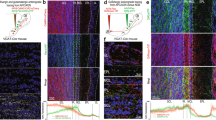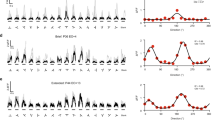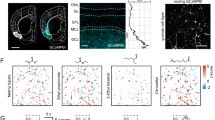Abstract
Sensory maps are created by networks of neuronal responses that vary with their anatomical position, such that representations of the external world are systematically and topographically organized in the brain. Current understanding from studying excitatory maps is that maps are sculpted and refined throughout development and/or through sensory experience. Investigating the mouse olfactory bulb, where ongoing neurogenesis continually supplies new inhibitory granule cells into existing circuitry, we isolated the development of sensory maps formed by inhibitory networks. Using in vivo calcium imaging of odor responses, we compared functional responses of both maturing and established granule cells. We found that, in contrast to the refinement observed for excitatory maps, inhibitory sensory maps became broader with maturation. However, like excitatory maps, inhibitory sensory maps are sensitive to experience. These data describe the development of an inhibitory sensory map as a network, highlighting the differences from previously described excitatory maps.
This is a preview of subscription content, access via your institution
Access options
Subscribe to this journal
Receive 12 print issues and online access
$209.00 per year
only $17.42 per issue
Buy this article
- Purchase on Springer Link
- Instant access to full article PDF
Prices may be subject to local taxes which are calculated during checkout








Similar content being viewed by others
References
Markram, H. et al. Interneurons of the neocortical inhibitory system. Nat. Rev. Neurosci. 5, 793–807 (2004).
Cang, J. & Feldheim, D.A. Developmental mechanisms of topographic map formation and alignment. Annu. Rev. Neurosci. 36, 51–77 (2013).
Iwasato, T. et al. NMDA receptor-dependent refinement of somatotopic maps. Neuron 19, 1201–1210 (1997).
Gordon, J.A. & Stryker, M.P. Experience-dependent plasticity of binocular responses in the primary visual cortex of the mouse. J. Neurosci. 16, 3274–3286 (1996).
Ackman, J.B., Burbridge, T.J. & Crair, M.C. Retinal waves coordinate patterned activity throughout the developing visual system. Nature 490, 219–225 (2012).
Kakizawa, S., Yamasaki, M., Watanabe, M. & Kano, M. Critical period for activity-dependent synapse elimination in developing cerebellum. J. Neurosci. 20, 4954–4961 (2000).
White, J.J. et al. Cerebellar zonal patterning relies on Purkinje cell neurotransmission. J. Neurosci. 34, 8231–8245 (2014).
Thivierge, J.P. & Marcus, G.F. The topographic brain: from neural connectivity to cognition. Trends Neurosci. 30, 251–259 (2007).
Taniguchi, H. et al. A resource of Cre driver lines for genetic targeting of GABAergic neurons in cerebral cortex. Neuron 71, 995–1013 (2011).
Murphey, D.K., Herman, A.M. & Arenkiel, B.R. Dissecting inhibitory brain circuits with genetically-targeted technologies. Front. Neural Circuits 8, 124 (2014).
Sohya, K., Kameyama, K., Yanagawa, Y., Obata, K. & Tsumoto, T. GABAergic neurons are less selective to stimulus orientation than excitatory neurons in layer II/III of visual cortex, as revealed by in vivo functional Ca2+ imaging in transgenic mice. J. Neurosci. 27, 2145–2149 (2007).
Kerlin, A.M., Andermann, M.L., Berezovskii, V.K. & Reid, R.C. Broadly tuned response properties of diverse inhibitory neuron subtypes in mouse visual cortex. Neuron 67, 858–871 (2010).
Cazakoff, B.N., Lau, B.Y., Crump, K.L., Demmer, H.S. & Shea, S.D. Broadly tuned and respiration-independent inhibition in the olfactory bulb of awake mice. Nat. Neurosci. 17, 569–576 (2014).
Fino, E. & Yuste, R. Dense inhibitory connectivity in neocortex. Neuron 69, 1188–1203 (2011).
Nusser, Z., Kay, L.M., Laurent, G., Homanics, G.E. & Mody, I. Disruption of GABAA receptors on GABAergic interneurons leads to increased oscillatory power in the olfactory bulb network. J. Neurophysiol. 86, 2823–2833 (2001).
Lagier, S., Carleton, A. & Lledo, P.M. Interplay between local GABAergic interneurons and relay neurons generates gamma oscillations in the rat olfactory bulb. J. Neurosci. 24, 4382–4392 (2004).
Sohal, V.S., Zhang, F., Yizhar, O. & Deisseroth, K. Parvalbumin neurons and gamma rhythms enhance cortical circuit performance. Nature 459, 698–702 (2009).
Kuhlman, S.J., Tring, E. & Trachtenberg, J.T. Fast-spiking interneurons have an initial orientation bias that is lost with vision. Nat. Neurosci. 14, 1121–1123 (2011).
Ohki, K., Chung, S., Ch'ng, Y.H., Kara, P. & Reid, R.C. Functional imaging with cellular resolution reveals precise micro-architecture in visual cortex. Nature 433, 597–603 (2005).
Shepherd, G.M. The Synaptic Organization of the Brain 5th edn. (Oxford Univ. Press, 2004).
Carleton, A., Petreanu, L.T., Lansford, R., Alvarez-Buylla, A. & Lledo, P.M. Becoming a new neuron in the adult olfactory bulb. Nat. Neurosci. 6, 507–518 (2003).
Vassar, R. et al. Topographic organization of sensory projections to the olfactory bulb. Cell 79, 981–991 (1994).
Mombaerts, P. et al. Visualizing an olfactory sensory map. Cell 87, 675–686 (1996).
Belluscio, L. & Katz, L.C. Symmetry, stereotypy, and topography of odorant representations in mouse olfactory bulbs. J. Neurosci. 21, 2113–2122 (2001).
Isaacson, J.S. & Strowbridge, B.W. Olfactory reciprocal synapses: dendritic signaling in the CNS. Neuron 20, 749–761 (1998).
Margrie, T.W., Sakmann, B. & Urban, N.N. Action potential propagation in mitral cell lateral dendrites is decremental and controls recurrent and lateral inhibition in the mammalian olfactory bulb. Proc. Natl. Acad. Sci. USA 98, 319–324 (2001).
Bozza, T., McGann, J.P., Mombaerts, P. & Wachowiak, M. In vivo imaging of neuronal activity by targeted expression of a genetically encoded probe in the mouse. Neuron 42, 9–21 (2004).
Soucy, E.R., Albeanu, D.F., Fantana, A.L., Murthy, V.N. & Meister, M. Precision and diversity in an odor map on the olfactory bulb. Nat. Neurosci. 12, 210–220 (2009).
Rubin, B.D. & Katz, L.C. Optical imaging of odorant representations in the mammalian olfactory bulb. Neuron 23, 499–511 (1999).
Spors, H. & Grinvald, A. Spatio-temporal dynamics of odor representations in the mammalian olfactory bulb. Neuron 34, 301–315 (2002).
Wachowiak, M. et al. Optical dissection of odor information processing in vivo using GCaMPs expressed in specified cell types of the olfactory bulb. J. Neurosci. 33, 5285–5300 (2013).
Kohwi, M. et al. A subpopulation of olfactory bulb GABAergic interneurons is derived from Emx1- and Dlx5/6-expressing progenitors. J. Neurosci. 27, 6878–6891 (2007).
Garcia, I. et al. Local CRH signaling promotes synaptogenesis and circuit integration of adult-born neurons. Dev. Cell 30, 645–659 (2014).
Garcia, I. et al. Local corticotropin releasing hormone (CRH) signals to its receptor CRHR during postnatal development of the mouse olfactory bulb. Brain Struct. Funct. 221, 1–20 (2016).
Chen, Q. et al. Imaging neural activity using Thy1-GCaMP transgenic mice. Neuron 76, 297–308 (2012).
Chen, T.W. et al. Ultrasensitive fluorescent proteins for imaging neuronal activity. Nature 499, 295–300 (2013).
Shipley, M.T. & Adamek, G.D. The connections of the mouse olfactory bulb: a study using orthograde and retrograde transport of wheat germ agglutinin conjugated to horseradish peroxidase. Brain Res. Bull. 12, 669–688 (1984).
Laaris, N., Puche, A. & Ennis, M. Complementary postsynaptic activity patterns elicited in olfactory bulb by stimulation of mitral/tufted and centrifugal fiber inputs to granule cells. J. Neurophysiol. 97, 296–306 (2007).
Balu, R., Pressler, R.T. & Strowbridge, B.W. Multiple modes of synaptic excitation of olfactory bulb granule cells. J. Neurosci. 27, 5621–5632 (2007).
Huang, L. et al. Task learning promotes plasticity of interneuron connectivity maps in the olfactory bulb. J. Neurosci. 36, 8856–8871 (2016).
Cummings, D.M., Henning, H.E. & Brunjes, P.C. Olfactory bulb recovery after early sensory deprivation. J. Neurosci. 17, 7433–7440 (1997).
Shepherd, G.M., Chen, W.R., Willhite, D., Migliore, M. & Greer, C.A. The olfactory granule cell: from classical enigma to central role in olfactory processing. Brain Res. Rev. 55, 373–382 (2007).
Hensch, T.K. Critical period plasticity in local cortical circuits. Nat. Rev. Neurosci. 6, 877–888 (2005).
Ehrlich, I. et al. Amygdala inhibitory circuits and the control of fear memory. Neuron 62, 757–771 (2009).
Breton-Provencher, V., Lemasson, M., Peralta, M.R. III & Saghatelyan, A. Interneurons produced in adulthood are required for the normal functioning of the olfactory bulb network and for the execution of selected olfactory behaviors. J. Neurosci. 29, 15245–15257 (2009).
Moreno, M.M. et al. Olfactory perceptual learning requires adult neurogenesis. Proc. Natl. Acad. Sci. USA 106, 17980–17985 (2009).
Sakamoto, M. et al. Continuous postnatal neurogenesis contributes to formation of the olfactory bulb neural circuits and flexible olfactory associative learning. J. Neurosci. 34, 5788–5799 (2014).
Alonso, M. et al. Olfactory discrimination learning increases the survival of adult-born neurons in the olfactory bulb. J. Neurosci. 26, 10508–10513 (2006).
Mandairon, N. et al. Neurogenic correlates of an olfactory discrimination task in the adult olfactory bulb. Eur. J. Neurosci. 24, 3578–3588 (2006).
Monory, K. et al. The endocannabinoid system controls key epileptogenic circuits in the hippocampus. Neuron 51, 455–466 (2006).
Justice, N.J., Yuan, Z.F., Sawchenko, P.E. & Vale, W. Type 1 corticotropin-releasing factor receptor expression reported in BAC transgenic mice: implications for reconciling ligand-receptor mismatch in the central corticotropin-releasing factor system. J. Comp. Neurol. 511, 479–496 (2008).
Arenkiel, B.R. et al. In vivo light-induced activation of neural circuitry in transgenic mice expressing channelrhodopsin-2. Neuron 54, 205–218 (2007).
Acknowledgements
We would like to thank A. Herman, C. Kim, H. Lu, D. Murphey, K. Schulze and R. Sillitoe for discussion and critical input on this manuscript. This work was supported by the McNair Medical Institute, the Charif Souki Fund, IRACDA Fellowship K12 GM084897 to K.Q., NRSA F31NS089178 to K.U., NINDS grant F31NS081805 to I.G., NINDS R01NS078294 to B.R.A., U54HD083092 to the BCM IDDRC, and the Intelligence Advanced Research Projects Activity (IARPA) via Department of Interior/Interior Business Center (DoI/IBC) contract number D16PC00003 to A.S.T. The US Government is authorized to reproduce and distribute reprints for Governmental purposes notwithstanding any copyright annotation thereon. Disclaimer: The views and conclusions contained herein are those of the authors and should not be interpreted as necessarily representing the official policies or endorsements, either expressed or implied, of IARPA, DoI/IBC or the US Government.
Author information
Authors and Affiliations
Contributions
K.B.Q. and B.R.A. designed the study, performed the analysis and wrote the manuscript. K.B.Q. performed most of the experiments. K.U. contributed to the behavior and wide-field imaging. E.F. and A.S.T. performed the two-photon experiments. L.H. performed the optogenetic mapping experiments on the AOD set up designed by L.H., K.C., P.S. and B.R.A. A.P.A., J.O.-G. and I.H. assisted with behavior, histology and surgeries.
Corresponding author
Ethics declarations
Competing interests
The authors declare no competing financial interests.
Integrated supplementary information
Supplementary Figure 1 Stable cell morphology.
(a) Overview of olfactory bulb slices from Dlx5/6-Cre and Crhr1-Cre animals injected with high titer AAV-flex-GFP (Scale bar 500 μm). (b) Example GFP neuron outlines as traced in Neurolucida from immature Dlx5/6-Cre + AAV-flex-GFP (left) and mature Crhr1-Cre + AAV-flex-GFP (right) animals (Scale bar 50 μm). No significant changes in the size of the cell body (c), total apical dendrite length (d), number of basal dendrites (e) or the distance from the mitral cell layer (f). (data point represent individual cells, red line at the mean ±SEM).
Supplementary Figure 2 Viral GCaMP expression does not change the membrane properties of granule cells.
No significant changes between Dlx5/6 expressing neurons labeled with viral GFP or GCaMP6 measured by (a) membrane capacitance p = 0.1315, (b) membrane resistance p = 0.1626, (c) action potential half-width p = 0.9024, (d) frequency-current curves, (e) resting potential p = 0.4202, (f) current required for action potential (resting potential between -60 and -65 mV)p = 0.0720, or (g) time to action potential peak in response to 30 pA current injection p = 0.5480. (data points represent individual cells, bars at averages ± SEM, n = 26 for GFP, n = 11 for GCaMP6).
Supplementary Figure 3 Analyzing ΔF/F of pentanol activation.
(a and b) Example sensory map for pentanol (top), and the area activated at 50% or more of the maximal change in fluorescence (50% max ΔF/F) (bottom) (Scale bar 1 mm). (c) No change in maximal ΔF/F value across animals. (d) Significant increase in the 50% max ΔF/F area of the mature granule cells. (data points represent individual animals, bar at mean ± SEM, n = 7 animals per genotype, minimum of 3 trials per odorant, * p = 0.0491 Students t-test)
Supplementary Figure 4 Broader sensory maps of mature inhibitory neurons for multiple stimuli.
Example ΔF sensory map for anisole (a and b), and isoamyl acetate (e and f) (Scale bar 1 mm). (c and g) No change in maximal ΔF value across animals. Significant increase in the 50% max ΔF area of the mature granule cells for both (d) p=0.0187 and (h) p=0.0345. (data points represent individual animals, bars at mean ± SEM, n = 7 animals per genotype, minimum of 3 trials per odorant, * p<0.05 Students t-test)
Supplementary Figure 5 Inhibitory sensory maps broaden with maturation regardless of genetic marker.
a) Example ΔF sensory maps for pentanol for a Dlx5/6-Cre animal 2-3 weeks after viral injection (top), a Crhr1-Cre animal 2-3 weeks after viral injection (middle) and a Dlx5/6-Cre animal 6-8 weeks after viral injection (bottom) (Scale bar 1 mm). (b) Significant increase in the 50% max ΔF area of the mature granule cells across stimuli regardless of genetic marker (data points represent averages ± SEM, n = 7 Dlx5/6, n = 7 Crhr1, n = 3 Dlx5/6 6-8 weeks, minimum of 3 trials per odorant, * p<0.05, ** p<0.01 One-way ANOVA, Sidak’s multiple comparison).
Supplementary Figure 6 AOD-assisted optogenetic targeting of mitral cells.
(a) Diagram of AOD microscope and patched cells, (yellow = mitral cells as in Supplemental Fig. 6, red = granule cell as in Fig. 5). (b) Example patched mitral cell and location of light stimulation grid to ensure excitation of mitral cells was limited to stimulation over cell body as quantified in (c) which shows the probability of eliciting and action potential from AOD stimulation over a 30 μm2 grid around a patched mitral cell (asterisk) (n = 6 mitral cells). (d) Representative action potentials elicited from light stimulation over the soma of an example mitral cell. (Scale bar: 10 mV, 5 ms).
Supplementary Figure 7 Olfactory learning and immature granule cell synaptic changes.
(a) Performance of mice across many trials (about 200 trials/day) increases through training. (data points represent averages ± SEM, n = 10 animals for Dlx5/6-Cre and n=12 for Crhr1-Cre). (b) Example ΔF sensory maps for control and trained Dlx5/6-Cre mice in response to the S- odor (carvone(+)) and a novel odor (anisole) (e and f) and quantification in (c) showing map expansion is generalizable to other trained odors. (data points represent individual animals, bar at mean values ± SEM, n = 5 animals trained, 6 animals control, * p = 0.0123, One-way ANOVA, Sidak’s correction). (d) Representative mEPSC traces from Dlx5/6 expressing neurons from either control (top) or trained animals (bottom) with example averaged event on right (Scale bars full trace: 20 pA, 1 s; average: 8 pA, 10 ms). (e) Cumulative interval and (f) cumulative amplitude are significantly different in control versus trained mice (p < 0.0001 KS test), however the mean frequency (e, inset) shows increased variance (F test p < 0.0001) and trend toward increased frequency and no change in mean amplitude (f, inset) (data points represent individual cells, bars at mean values ± SEM, for mini data: n = 13 control granule cells and 12 trained cells from 4 animals each control and trained, injected with AAV-flex-GFP or AAV-flex-tdTomato).
Supplementary Figure 8 Passive odor exposure does not expand inhibitory sensory maps.
(a) Diagram of experimental setup showing 2 tea-strainer balls containing different odors that were hung in the animal’s home cage for an hour per day. (b) Timeline of experiment. (c) Example ΔF sensory maps for control and exposed mice in response to one exposed odor (anisole) and a novel odor (acetephenone) and quantification in (d) showing map no expansion. (data points represent individual animals, bars at mean values ± SEM, n = 4 Dlx5/6-Cre animals control, 4 Dlx5/6-Cre animals exposed, all injected with AAV-flex-GCaMP6m).
Supplementary Figure 9 Olfactory learning does not expand sensory maps for mature granule cells.
(a) Representative ΔF sensory map for control and trained mice in response to the unrewarded trained odor (carvone (+) and a novel odor (anisole) (scale bar 1 mm). (b) Mean activated area (± SEM, n = 4 animals control, 4 animals exposed all Crhr1-Cre injected with AAV-flex-GCaMP6). (c) Representative mEPSC traces from Crhr1 expressing neurons from either control (left) or trained animals (right) with example averaged event below (Scale bars full trace: 20 pA, 1 s; average: 8 pA, 10 ms). Cumulative interval distribution (d) and amplitude distribution (e) with cell means inset. (bar graphs represent mean values ± SEM, for mini data: n = 13 control granule cells and 8 occluded cells from 4 Crhr1-Cre animals + AAV-flex-GFP, each control and trained).
Supplementary information
Supplementary Text and Figures
Supplementary Figures 1–9 (PDF 1609 kb)
Rights and permissions
About this article
Cite this article
Quast, K., Ung, K., Froudarakis, E. et al. Developmental broadening of inhibitory sensory maps. Nat Neurosci 20, 189–199 (2017). https://doi.org/10.1038/nn.4467
Received:
Accepted:
Published:
Issue Date:
DOI: https://doi.org/10.1038/nn.4467
This article is cited by
-
Olfactory bulb astrocytes mediate sensory circuit processing through Sox9 in the mouse brain
Nature Communications (2021)
-
The maps they are a-changin': plasticity in odor representation in interneurons
Nature Neuroscience (2017)



